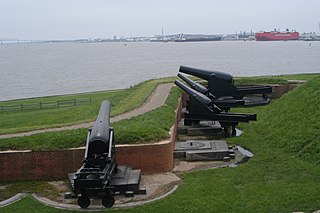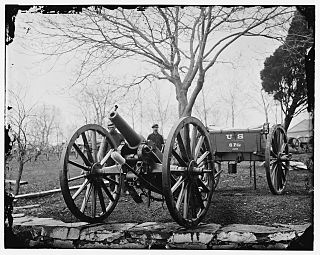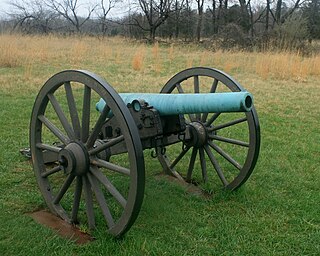
Cape Girardeau is a city in Cape Girardeau and Scott Counties in the U.S. state of Missouri. At the 2020 census, the population was 39,540. The city is the economic center of rural Southeast Missouri and also an emerging college town as the home of Southeast Missouri State University. It is located approximately 100 miles (161 km) southeast of St. Louis and 150 miles (241 km) north of Memphis.

The Rodman gun is any of a series of American Civil War–era columbiads designed by Union artilleryman Thomas Jackson Rodman (1815–1871). The guns were designed to fire both shot and shell. These heavy guns were intended to be mounted in seacoast fortifications. They were built in 8-inch, 10-inch, 13-inch, 15-inch, and 20-inch bore. Other than size, the guns were all nearly identical in design, with a curving bottle shape, large flat cascabels with ratchets or sockets for the elevating mechanism. Rodman guns were true guns that did not have a howitzer-like powder chamber, as did many earlier columbiads. Rodman guns differed from all previous artillery because they were hollow cast, a new technology that Rodman developed that resulted in cast-iron guns that were much stronger than their predecessors.

Fort Fisher was a Confederate fort during the American Civil War. It protected the vital trading routes of the port at Wilmington, North Carolina, from 1861 until its capture by the Union in 1865. The fort was located on one of Cape Fear River's two outlets to the Atlantic Ocean on what was then known as Federal Point or Confederate Point and today is known as Pleasure Island. The strength of Fort Fisher led to its being called the Southern Gibraltar and the "Malakoff Tower of the South". The battle of Fort Fisher was the most decisive battle of the Civil War fought in North Carolina.

The Battle of Cape Girardeau was a military demonstration of the American Civil War, occurring on April 26, 1863 in Cape Girardeau, Missouri. The conflict was part of the pursuit of US Brigadier General John McNeil through Southeast Missouri by Confederate Brigadier General John S. Marmaduke. Though the conflict to this day is known as a battle, it was a relatively small engagement whose primary importance was as the turning point that brought General Marmaduke's second Missouri raid to an end.

The Siege of Fort Pulaski concluded with the Battle of Fort Pulaski fought April 10–11, 1862, during the American Civil War. Union forces on Tybee Island and naval operations conducted a 112-day siege, then captured the Confederate-held Fort Pulaski after a 30-hour bombardment. The siege and battle are important for innovative use of rifled guns which made existing coastal defenses obsolete. The Union initiated large-scale amphibious operations under fire.

The Cape Girardeau Bridge was a continuous through truss bridge connecting Missouri's Route 34 with Illinois Route 146 across the Mississippi River between Cape Girardeau, Missouri, and East Cape Girardeau, Illinois. It was replaced in 2003 with the Bill Emerson Memorial Bridge.
Southeast Hospital is a private, not-for-profit hospital located in Cape Girardeau, Missouri. Southeast Missouri Hospital first opened in 1928 and has grown into a regional medical complex serving over 600,000 people in 22 counties in Southeast Missouri and Southern Illinois. In 2007, the hospital had 269 licensed beds, 11,487 admissions and employed over 2,000 people.

Seacoast defense was a major concern for the United States from its independence until World War II. Before airplanes, many of America's enemies could only reach it from the sea, making coastal forts an economical alternative to standing armies or a large navy. After the 1940s, it was recognized that fixed fortifications were obsolete and ineffective against aircraft and missiles. However, in prior eras foreign fleets were a realistic threat, and substantial fortifications were built at key locations, especially protecting major harbors.

Siege artillery is heavy artillery primarily used in military attacks on fortified positions. At the time of the American Civil War, the U.S. Army classified its artillery into three types, depending on the gun's weight and intended use. Field artillery were light pieces that often traveled with the armies. Siege and garrison artillery were heavy pieces that could be used either in attacking or defending fortified places. Seacoast artillery were the heaviest pieces and were intended to be used in permanent fortifications along the seaboard. They were primarily designed to fire on attacking warships. The distinctions are somewhat arbitrary, as field, siege and garrison, and seacoast artillery were all used in various attacks and defenses of fortifications. This article will focus on the use of heavy artillery in the attack of fortified places during the American Civil War.

The Wiard rifle refers to several weapons invented by Norman Wiard, most commonly a semi-steel light artillery piece in six-pounder and twelve-pounder calibers. About 60 were manufactured between 1861 and 1862 during the American Civil War, at O'Donnell's Foundry, New York City: "although apparently excellent weapons, [they] do not seem to have been very popular". Wiard also designed a rifled steel version of the Dahlgren boat howitzer, among other gun types. Further, Wiard unsuccessfully attempted to develop a 15 in (381 mm) rifled gun for the US Navy and proposed a 20 in (510 mm) gun. In 1881 he unsuccessfully proposed various "combined rifle and smoothbore" weapon conversions of Rodman guns and Parrott rifles.
Charles Carroll Marsh was a Union Army officer during the American Civil War. He served with distinction early in the war at the battles of Fort Donelson and Shiloh. He is commonly referred to as "C. Carrol Marsh" in official reports.

Fort Stark is a former military fortification in New Castle, New Hampshire, United States. Located at Jerry's Point on the southeastern tip of New Castle Island, most of the surviving fort was developed in the early 20th century, following the Spanish–American War, although there were several earlier fortifications on the site, portions of which survive. The fort was named for John Stark, a New Hampshire officer who distinguished himself at the Battle of Bennington in the American Revolution. The purpose of Fort Stark was to defend the harbor of nearby Portsmouth and the Portsmouth Naval Shipyard. The fort remained in active use through the Second World War, after which it was used for reserve training by the US Navy. The property was partially turned over to the state of New Hampshire in 1979, which established Fort Stark Historic Site, and the remainder of the property was turned over in 1983. The grounds are open to the public during daylight hours.
Sloan Creek is a stream in eastern Cape Girardeau County, Missouri, in the United States. It is a tributary to the Mississippi River.
Battery D, 2nd Missouri Light Artillery Regiment was an artillery battery that served in the Union Army during the American Civil War and Plains Indian Wars.

Battery B, 1st Missouri Light Artillery Regiment, also known as Welfley's Independent Missouri Battery, was an artillery battery that served in the Union Army during the American Civil War. Organized in September 1861, Welfley's Independent Battery fought at Pea Ridge and in the White River campaign. After its name changed to Battery B, 1st Missouri in December 1862, it fought at Cape Girardeau, Chalk Bluff, Vicksburg, Sterling's Plantation, and Brownsville. In September 1864, the unit ceased to exist when it was consolidated with three other Missouri batteries while stationed at New Orleans.

The 14-pounder James rifle or James rifled 6-pounder or 3.8-inch James rifle was a bronze muzzle-loading rifled cannon that was employed by the United States Army and the Confederate States Army during the American Civil War. It fired a 14 lb (6.4 kg) solid shot up to a distance of 1,530 yd (1,400 m) at 5° elevation. It could also fire canister shot and common shell. Shortly before the war broke out, the U.S. Army adopted a plan to convert M1841 6-pounder field guns from smoothbore to rifled artillery. Rifling the existing 6-pounders would both improve the gun's accuracy and increase the weight of the shell. There were two major types produced, both were bronze with a bore (caliber) of 3.8 in (97 mm) that would accommodate ammunition designed by Charles Tillinghast James. The first type looked exactly like an M1841 6-pounder field gun. The second type had a longer tube with a smooth exterior profile similar to a 3-inch Ordnance rifle. At first the rifles were quite accurate. However, it was discovered that the bronze rifling quickly wore out and accuracy declined. None of the rifles were manufactured after 1862, and many were withdrawn from service, though some artillery units employed the guns until the end of the war.

The 6th Missouri Infantry was an infantry regiment of the Confederate States Army during the American Civil War. The regiment was formed on August 26, 1862, when two existing units were combined. Later that year, the regiment was then lightly engaged at the Battle of Iuka and saw heavy action at the Second Battle of Corinth. In 1863, the regiment was engaged at the Battle of Port Gibson, and was part of a major charge at the Battle of Champion Hill. After a defeat at the Battle of Big Black River Bridge, the regiment took part in the siege of Vicksburg, where it saw heavy fighting. The siege of Vicksburg ended on July 4th with a Confederate surrender; after being exchanged, the regiment combined with the 2nd Missouri Infantry to form the 2nd and 6th Missouri Infantry (Consolidated). The 6th Missouri Infantry ceased to exist as a separate unit.

Battery E, 1st Missouri Light Artillery Regiment was an artillery battery unit from Missouri that served in the Union Army during the American Civil War. The 1st Missouri Light Artillery Regiment formed on 1 September 1861. The battery participated in Frémont's expedition to Springfield in October 1861. This was followed by actions at Prairie Grove and Van Buren in December 1862. The following year, the battery fought at Cape Girardeau, Chalk Bluff, Vicksburg, the Expedition to Morganza, Brownsville, and Fort Esperanza. After performing garrison duty at Brownsville, Texas, the unit was mustered out in June 1864. For a few months at the end of 1864, a Pennsylvania battery took the name of this unit.

Battery "F", 2nd Illinois Light Artillery Regiment was an artillery battery from Illinois that served in the Union Army during the American Civil War. The battery was organized in December 1861 at Cape Girardeau, Missouri. The unit fought at Shiloh, First Corinth, and Second Corinth in 1862 and at Vicksburg and Jackson in 1863. The battery served in the Atlanta campaign and at Nashville in 1864. It was mustered out of federal service in July 1865. The battery's first commander was John Wesley Powell who later led an exploration of the Grand Canyon.



















